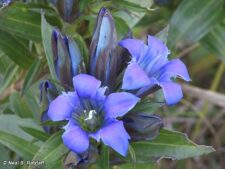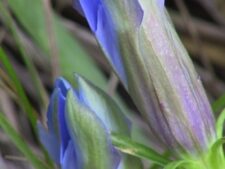
This native perennial has an unbranched stem 1-2 feet tall. The opposite, stalkless leaves are less than 2 inches long and 1 inch wide (A). The erect flowers are crowded in a cluster at the top of the plant. One of nature’s last and best gifts of the fall season, these funnel-shaped 1 1/2 inch flowers are a deep blue to blue-violet color, often with greenish or whitish lines deep inside (A,B). The 5 spreading petals have pointed tips and are connected to each other by small fringed segments. Flowers close in the evening and open about mid-morning on sunny days. They may not open on cloudy days (C).
Grows in moist to dry upland prairies, flowering in September and October. Downy Gentian is rare at Neale Woods.
Clusters of flowers with fringed segments connecting the petals separate downy gentian from Prairie Gentian (Eustoma grandiflorum), a plant not found locally but widely distributed in Nebraska. It has no fringed pleats and flowers earlier in the season. Bottle Gentian (G. andrewsii), last seen at Fontenelle Forest in 1959, has a tubular blue flower whose petals never open.
Dinsmore writes that it was called “blue-blossom” medicine by the Winnebagos and “yellow medicine” (for the root color) by the Dakota. A preparation made from the roots was taken as a tonic. The genus is named for Gentius, ancient King of Illyria (180-167 BC) credited with introducing the European yellow gentian to medicine.
Another common name is Prairie Gentian.
The content of NatureSearch is provided by dedicated volunteer Naturalists of Fontenelle Forest who strive to provide the most accurate information available. Contributors of the images retain their copyrights. The point of contact for this page is: Neal Ratzlaff.

 Identification
Identification
